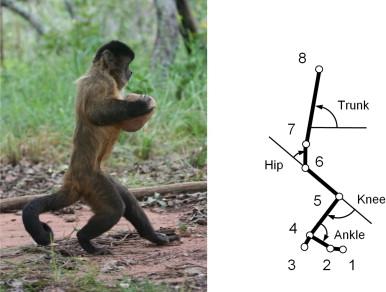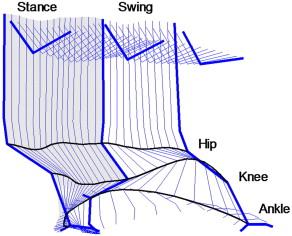Marcos Duartea, Jandy Hannab, Evandro Sanchesa, Qing Liuc, Dorothy Fragaszyc
Source - http://www.sciencedirect.com/science/article/pii/S0047248412001807
Abstract Journal of Human Evolution
Understanding the selective pressures that drove the evolution of bipedalism in the human lineage may help inform researchers about the locomotor mode(s) of pre-hominin ancestors. Several selective pressures have been hypothesized, including the need to carry food, tools, or infants. Bearded capuchin monkeys are an excellent primate in which to examine the hypothesis that carrying supported the evolution of bipedalism because they are morphologically generalized and in some ways similar to Miocene hominoids, from which the transitional biped evolved. Additionally, bearded capuchins regularly move bipedally while carrying tools that represent a significant portion of their body mass. Here, we examined the spatio-temporal and kinematic gait parameters in a wild setting of Sapajus libidinosus moving bipedally while carrying a stone tool, as well as unloaded bipedal tufted capuchins in the lab. Results indicate that compared with humans, the monkeys move with a more bent-hip, bent-knee posture during both types of bipedalism, as expected. Few differences exist in spatio-temporal or kinematic parameters within species across load-carrying and unloaded bipedalism. The capuchin ankle, however, during load-carrying goes through a greater range of motion in relatively less time than both humans and unloaded capuchins. Data from this study provide the first quantitative data on bipedalism during load-carrying by wild primates in a natural setting. As such, they are a useful comparative reference for understanding bipedalism, particularly during load-carrying.

View of the experimental area across which the monkeys transported a stone and a nut on their way to an anvil (off view to the right). The substrate was level, nearly horizontal, compact sandy soil, raked free of vegetation, roots, etc. The flags on the left marked the position where the stone and nut were placed on the ground. The moderately sheer fabric panel behind the monkey was hung on a horizontal pole. The panel provided a homogeneous visual background, improving visibility of the monkey in video playback. The monkeys habituated quickly to these features and carried the stone and nut in a direct line from the pick-up point to the anvil. Photo by Rebecca Greenberg.

A bearded capuchin monkey (Sapajus libidinosus) carrying a stone and a nut (left). Photo by Noemi Spagnoletti. The anthropometric model employed to describe movement, and the joint angle convention (right). The anatomical landmarks digitized were: 1. Tip of the second toe; 2. Second metatarsal phalangeal; 3. Heel; 4. Lateral malleolus; 5. Knee joint center; 6. Trochanter; 7 Iliac crest; 8. C5 vertebra.

Stick figure of one representative gait stride movement of one bearded capuchin monkey.